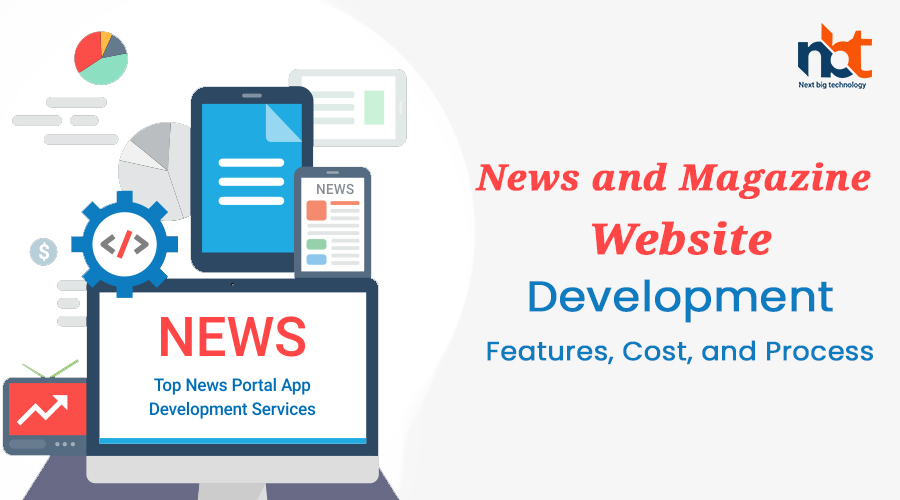News and magazine websites play a crucial role in disseminating information, covering current events, and engaging readers with a diverse range of topics. With the digital age, these websites have evolved to offer interactive experiences, multimedia content, and personalized news delivery. This comprehensive guide explores the key features, cost considerations, and step-by-step process involved in developing a dynamic and user-friendly news and magazine website.
Table of Contents
Introduction to News and Magazine Website Development
- Understanding News and Magazine Websites: Defining the role of online platforms in delivering news, articles, and features.
- Significance of Digital Media: Highlighting the importance of timely, accurate, and engaging content delivery.
Key Features of News and Magazine Websites
Content Categories and Navigation:
- Article Categories: Organizing content into categories such as politics, technology, lifestyle, etc.
- Navigation Menu: Providing intuitive navigation for easy access to different sections.
Featured Articles and Breaking News:
- Featured Stories: Showcasing top articles on the homepage for immediate engagement.
- Breaking News Alerts: Delivering real-time alerts for important news updates.
Multimedia Integration:
- Images and Galleries: Incorporating high-quality images and galleries to complement articles.
- Video Content: Embedding videos for news coverage, interviews, and features.
- Interactive Infographics: Using infographics to simplify complex information.
Personalization and User Accounts:
- User Profiles: Allowing users to create accounts for personalized content recommendations.
- Bookmarking and Saved Articles: Enabling users to save articles for later reading.
- Newsletter Subscription: Offering newsletter subscriptions for regular updates.
Social Sharing and Engagement:
- Social Media Integration: Allowing readers to easily share articles on social platforms.
- Comment Sections: Providing a space for readers to engage in discussions.
- Polls and Surveys: Incorporating interactive polls and surveys to gather opinions.
Responsive Design:
- Mobile Compatibility: Ensuring the website functions seamlessly on mobile devices.
- Mobile App Integration: Providing a dedicated app for convenient access.
Factors Influencing News and Magazine Website Development Cost
- Content Volume and Complexity: The extent of content categories, articles, and multimedia elements.
- Design and User Experience: Creating an appealing and user-friendly interface.
- Personalization Features: Implementing user profiles, bookmarks, and content recommendations.
- Multimedia Integration: Incorporating images, videos, and interactive graphics.
- Custom Development: Adding unique features such as custom widgets, search functionality, and subscription management.
- Mobile Responsiveness: Ensuring the website functions seamlessly on various mobile devices.
- Ongoing Maintenance: Regular updates, security checks, and technical support.
News and Magazine Website Development Process
1. Planning Phase
- Define Website Goals: Identify the primary purpose of the website (news coverage, features, analysis).
- Content Strategy: Plan the types of articles and categories to be featured.
- Design Concept: Determine the visual style, color scheme, and layout preferences.
- Technology Selection: Choose a content management system (CMS) suitable for news websites.
2. Design and Development Phase
- User Experience Design: Design an intuitive interface for easy navigation and content consumption.
- Content Creation: Develop high-quality articles, images, videos, and multimedia elements.
- Social Integration: Implement social sharing buttons and interactive features.
- Personalization Features: Integrate user accounts, bookmarks, and content recommendations.
3. Testing and Launch Phase
- Quality Assurance: Test article readability, multimedia integration, and interactive features.
- User Testing: Invite readers to navigate the website and provide feedback on usability.
- Mobile Testing: Ensure optimal performance and layout on various mobile devices.
- Security Checks: Implement security measures to protect user data and prevent spam.
4. Launch and Promotion Phase
- Final Deployment: Upload the website to the chosen hosting server.
- Content Promotion: Share articles on social media and engage with readers.
- User Engagement: Encourage users to create accounts, save articles, and share opinions.
- Analytics Setup: Implement tracking tools to monitor website traffic, user engagement, and popular articles.
5. Ongoing Maintenance and Updates
- Regular Content Updates: Keep articles current and relevant to the latest news.
- Technical Support: Address technical issues and user inquiries promptly.
- Performance Optimization: Regularly optimize website speed and loading times.
- Security Measures: Implement regular updates, security patches, and user data protection.
6. Choosing the Right Tools and Services
- Content Management Systems (CMS): Explore options like WordPress, Joomla, or custom news-focused platforms.
- Multimedia Integration: Utilize plugins for embedding images, videos, and interactive graphics.
- Social Sharing Tools: Implement social sharing buttons and plugins.
- User Account Management: Use membership plugins or custom development for user profiles.
- Mobile App Development: Consider developing a dedicated mobile app for easy access.
Conclusion
News and magazine websites serve as essential platforms for delivering information, engaging readers, and fostering discussions on a wide range of topics. The features you incorporate, the design complexity, and the ongoing maintenance efforts all contribute to the overall cost. By following a structured development process, leveraging appropriate tools, and prioritizing user experience, you can create a dynamic online platform that keeps readers informed and engaged while adapting to the ever-changing landscape of digital media.












